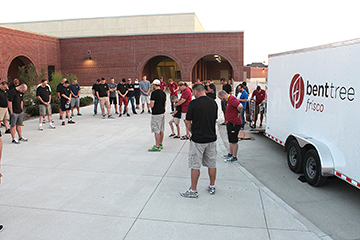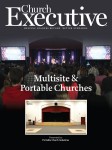
By Scott Cougill
 Your volunteer vision, strategy, attitude and approach to launching portable churches and campuses will greatly impact the success, discipleship, spiritual formation, community impact and long-term growth of your church.
Your volunteer vision, strategy, attitude and approach to launching portable churches and campuses will greatly impact the success, discipleship, spiritual formation, community impact and long-term growth of your church.
You’re going to begin life in a rented, secular space like a school, theater or community center. So, is your glass half full or half empty?
Your attitude and approach do matter!
 Attitude. Some church leaders view launching portability as a problem. Others treat it as an opportunity. The difference between a problem and an opportunity is what we do with it, not what it is to begin with.
Attitude. Some church leaders view launching portability as a problem. Others treat it as an opportunity. The difference between a problem and an opportunity is what we do with it, not what it is to begin with.
Let me paint two different approaches from my five years of leadership working inside and with portable churches.
Church of the Highlands in Birmingham, AL, has 12 church plants / sites, with many more in the pipeline. As their senior pastor, Chris Hodges, shared in the November / December 2015 issue of Church Executive, even though the church has funding to purchase buildings for each launch, they purposefully launch in portable venues to minimize overhead and maximize care for its volunteers and the community. Potential volunteers see that portability is Plan A and can be excited to join into the work that comes with it.
A different (unnamed) church plant meets in a school and regularly apologizes to the setup volunteers and thanks them for their hard work and sacrifice. “Someday we will have our own building; we just have to survive until then.” Pleas from stage for volunteers are frequent. New attenders feel guilty if they don’t take their turn at setup. Images of being a martyr and, “It’s thankless work, but we’ll receive our reward in heaven” reflect the attitude at this church. (I wish I were exaggerating …)
Churches that treat portability as an opportunity can be in position to have ministry impact that most permanent churches can’t. One huge unique ministry opportunity is capitalizing on engaging a large number of men on your volunteer teams and creating a community for men to serve, and get to know and minister to one another.
When established well, this makes it easier to connect new men attenders to other men in the congregation and establish a community where men get plugged in, contribute and grow. There are too many benefits to list in this brief article.

Approach. It turns out that the same principles that apply to recruiting and equipping volunteers in the other parts of church apply to the portable church setup and tear-down teams. One unique difference, however, is that — at first — often the Core Launch Team also serves as the Core Setup and Tear-Down Team. It’s a bit like playing both offense and defense in football.
Therefore, with portable churches, you need to develop an extra layer of structure, leadership, processes and care specific to setup and tear-down to maximize efficiency and minimize burnout.
Just like you wouldn’t try to lead your staff or a company without a defined organizational structure, you shouldn’t expect set-up and tear-down to go well without a clear, well-thought-out volunteer team structure. The best practice in this area is to have a volunteer foreperson who oversees the whole process and ensures your church’s quality and excellence standards are met each week. Likely, this foreperson would oversee other volunteer leaders like a volunteer setup / tear-down Worship Leader, Guest Services Leader, and Children’s / Youth Leader.
My team at Portable Church Industries has developed a free e-book that goes into many, many more specifics about volunteer structure, training, set-up strategies and staffing. If you’d like more information, you can download a copy here.
How many volunteers do you need to effectively staff this area? It depends — on the complexity of your worship setup, the quantity of aesthetic treatments needed, the number of children’s rooms, and whether or not you have invested in a specialized, efficient portable church system to organize everything. As a rule of thumb, if you have a clear structure and you use specialized equipment and systems designed for portable church environments, a setup team of 15 to 20 individuals for a church running 250 to 500 adults is common.
Most churches develop a rotating serving schedule so volunteers won’t burn out. One approach I’m seeing more often now with multi-site campuses and church plant launches with smaller core teams is that volunteers will serve each week, but there’s a modified service just for the volunteers before the main service.
For example, if the main service is at 10:30 a.m., but someday you’d like to also have a 9 a.m. service, the volunteers begin early so they finish by 9 a.m. Then, there’s a modified 9 a.m. service with extra prayer and a shortened sermon just for the volunteers. This way, volunteers don’t miss church, the team is strengthened, and the transition of adding a second service is easier.
Scott Cougill is CEO of Portable Church Industries in Troy, MI, a company that has partnered with more than 2,000 churches. Find Cougill on Twitter @ScottCougill.


